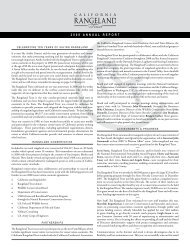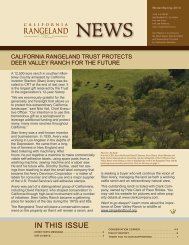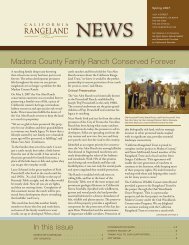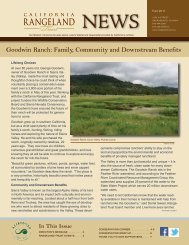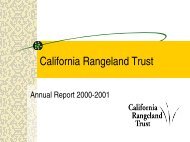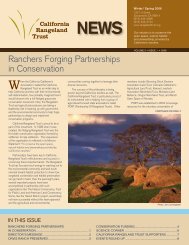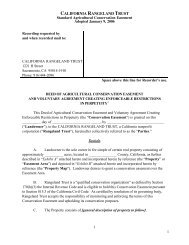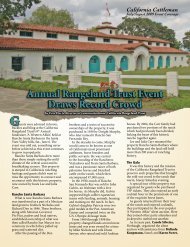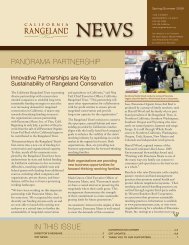IN THIS ISSuE - The California Rangeland Trust
IN THIS ISSuE - The California Rangeland Trust
IN THIS ISSuE - The California Rangeland Trust
You also want an ePaper? Increase the reach of your titles
YUMPU automatically turns print PDFs into web optimized ePapers that Google loves.
By Bill Reynolds<br />
<strong>The</strong> West holds hard to one of this country’s true rootbased<br />
cultures. <strong>The</strong> raising of protein within the ranching<br />
world is tied for many, to the image of stockman – the<br />
cowboy and his horse. It is that image that over the years<br />
has been utilized by many non-indigenous media – “civilian<br />
advertising” – to express certain qualities and “western<br />
values” the could ideally be tied to the products they were<br />
placed adjacent to. Honesty, hard work, self-reliance, a<br />
solid work ethic have all been associated with the image<br />
of the steadfast cowboy and ranching family. Does it<br />
work? Marlboro thought so, along<br />
with other diverse companies and<br />
brands. How and when did this<br />
evolution of such a directed task<br />
– that of tending cattle – become<br />
so visually important and ‘permission<br />
giving” passed it’s initial<br />
purpose? And more importantly, how can the cattle and<br />
ranching communities regain and re-purpose this important<br />
American image in these volatile times and changing political<br />
landscape? Let’s first look at how we got here.<br />
<strong>The</strong> West’s true popular influence – in a broad demographic<br />
sense - came with the innovation of the moving picture.<br />
<strong>The</strong> invention did in a very short time, what Buffalo Bill tried<br />
to do with his Wild West Show. His show ran for 30 years,<br />
from 1883 until 1913, touring the United States and Europe.<br />
Yet the western movie – with the help of Thomas Edison<br />
– started the ball really rolling. And it kept rolling until<br />
the late 1930s – really until the start of the Second World<br />
War. <strong>The</strong> early 1900s brought other incredible technological<br />
changes that<br />
played havoc with<br />
tradition, changes<br />
commented on<br />
by Montana writer<br />
William Kittredge.<br />
<strong>The</strong> changes he saw came to his world, the MC Ranch in<br />
southeastern Oregon. In his essay, “Running Horses,” he<br />
wrote of the changes that altered the lives of the people he<br />
grew up with and admired as their world ran headlong into<br />
modern life in the early 1900s:<br />
“<strong>The</strong>se people, they did the endless work, they took care,<br />
they were the people who invented our civilization, theirs<br />
was a tradition of civility. <strong>The</strong>se men who came before,<br />
Conservation Corner<br />
Media Usage and Its Impact in an Evolving West:<br />
How the culture of the West reaches out to enlist “civilians.”<br />
the horseback artists who brought the rawhide reata and<br />
the Spanish silver sided bits, were quick handed men who<br />
never dreamed they could own much beyond a saddle and<br />
a bedroll and a good pocket knife. <strong>The</strong>y were our nobility; I<br />
think they dreamed of capabilities and beauty. <strong>The</strong>y knew<br />
better than to imagine you could own anything beyond a<br />
coherent self.<br />
Those men, and the men I rode with on those deserts<br />
when I was a boy, lived in an ancient horseback world that<br />
is mostly gone. <strong>The</strong> nineteenth century lasted in our part<br />
of the universe until spring of 1946, when my grandfather<br />
traded off some two<br />
hundred matched<br />
teams for a fleet of<br />
John Deere tractors.<br />
Everybody thought it<br />
was a bold step into<br />
the future. We didn’t<br />
know what we were losing, our ancient proximity with animals,<br />
with running horses. <strong>The</strong> shadow of the clouds went<br />
on swiftly without us.”<br />
Honesty, hard work, self-reliance, a solid work<br />
ethic have all been associated with the image<br />
of the steadfast cowboy and ranching family.<br />
<strong>The</strong> West’s true popular influence - in a broad<br />
demographic sense - came with the innovation<br />
of the moving picture.<br />
After World War II, we ran to the future. Leaving much<br />
of the past behind. No more “yucks and shucks.” People<br />
wanted “the modern.” Big cars. Dish washing machines.<br />
Electric things. It wasn’t until the early 50s when everyone<br />
looked around and wondered where all the cowboys<br />
had gone. It was then the concept of the western-themed<br />
museum started to evolve, reminding us of our culture from<br />
the past. With television, the TV episodic western was born<br />
– from Sky King to Rin-Tin-Tin to Gunsmoke to Rawhide.<br />
<strong>The</strong> cowboy was king. <strong>The</strong>n the 60s. Bonanza, and a<br />
knock off of a James Bond movie with<br />
Robert Conrad in the Wild Wild West<br />
was all that really hung on. Fashion<br />
started changing. <strong>The</strong> election of President<br />
Kennedy was blamed with the<br />
end of the headwear business in this<br />
country - for the every man - as he was<br />
the first president to not wear a hat. Remember pictures of<br />
President Eisenhower? He was never without a hat. <strong>The</strong><br />
60s also brought the end of the TV western. And culturally,<br />
the West went sort of “dark” from a populous perspective<br />
until 1978.<br />
That year, writer Aaron Latham wrote about a dance club in<br />
Texas called Gilley’s. Two years later, the film version of the<br />
Continued on page 6<br />
www.rangelandtrust.org — 5




